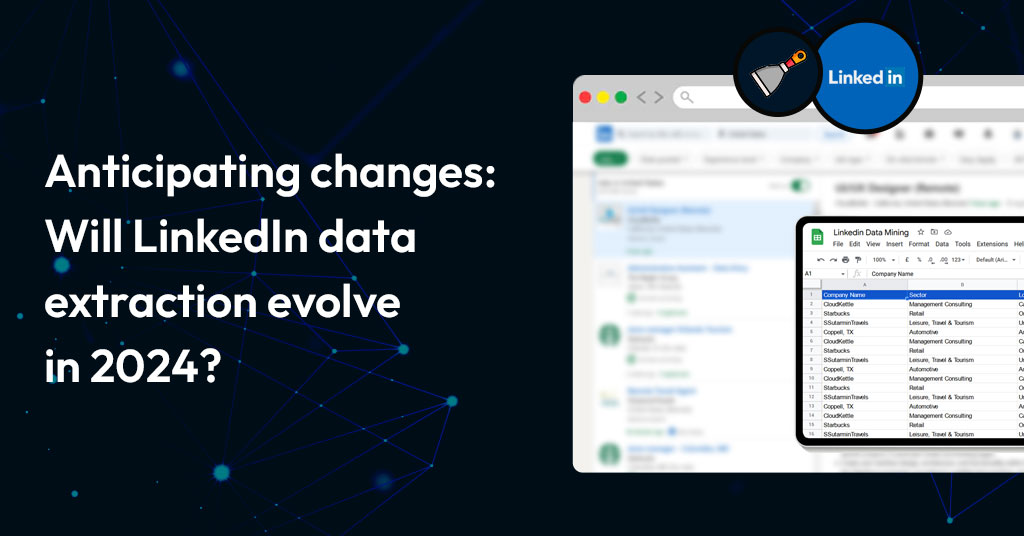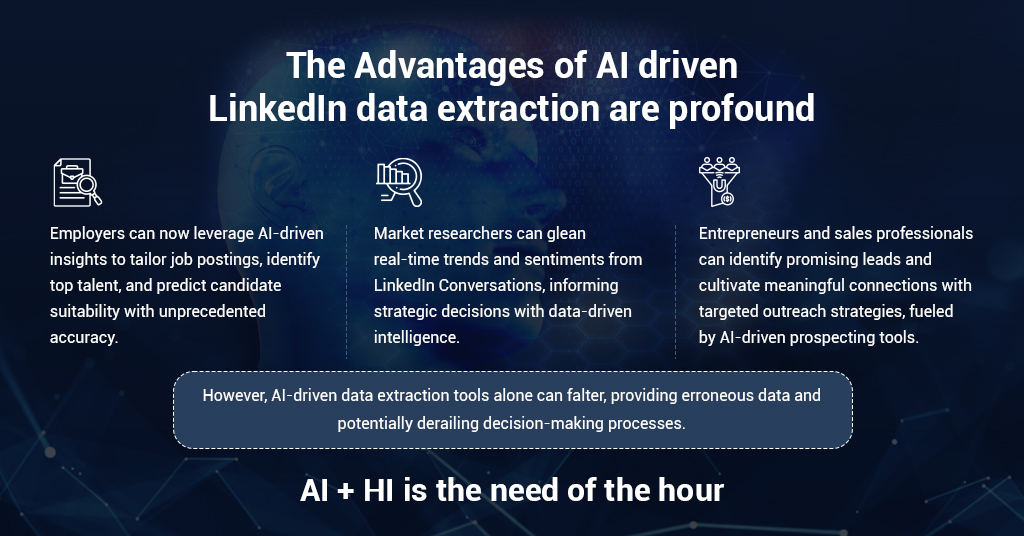
As businesses increasingly rely on data extraction and analysis to inform decision-making, a crucial question emerges: Will LinkedIn data extraction evolve in 2024? Read through to learn how LinkedIn data extraction experiences major transformation driven by AI. Conventional techniques, such as rotating IP addresses and proxies, are supplanted by AI-driven tools employing Natural Language Processing (NLP) for detailed public profile analysis. Additionally, we discuss how a collaborative AI+HI approach emerges as a key factor in data extraction, combining AI efficiency with HI’s contextual understanding.
Table of content
Will LinkedIn data extraction evolve in 2024?
LinkedIn data extraction has been a constant battle of adaptation for businesses, with success often reliant on technical expertise. Rotating IP addresses, using proxies, handling various scraping tools, and dealing with ever-changing HTML structures to extract data from LinkedIn profiles are most likely to continue being the reality of many businesses in 2023 and beyond.
But enter 2024, Artificial Intelligence (AI) is rapidly changing the LinkedIn data extraction landscape, making the process more efficient and accurate. AI-powered LinkedIn data extraction tools can now leverage Natural Language Processing (NLP) to understand the nuances of text within a profile. This allows them to extract not just basic contact information but also skills and experience details, providing a comprehensive view of LinkedIn profiles. Additionally, they can analyze sentiments from written content, gaining deeper insights into professional experiences and endorsements.
Imagine automatically identifying candidates who not only possess the required skills but also demonstrate a passion for your company culture through their profile descriptions! This is no longer science fiction – it’s the exciting new reality shaping the future of data extraction.
Major factors driving change in LinkedIn data extraction
1. Evolving user behavior on LinkedIn
User behavior on LinkedIn is undergoing a major transformation. Professionals are beginning to use Generative AI tools such as ChatGPT to reduce the time spent on tasks like drafting posts, responding to messages, and creating content for their profiles. Their focus now lies in honing human-centric and industry-specific skills that are more valuable and in demand.
With such shifts, the need for advanced data extraction tools becomes paramount.
Generative AI (GAI) is speeding up the transition toward a job market that focuses on new-age skills.
According to LinkedIn’s Skills-First Report, job skills have changed by 25% since 2015. If this trend persists, job roles could undergo approximately 60% transformation by 2030.
However, with the ongoing emergence of new GAI technologies, the pace and scale of changes to jobs are expected to escalate further. Experts predict an extra 5% increase, making it likely that jobs will change by about 65% by 2030.
Traditional methods of gathering data from LinkedIn profiles may fail to capture such nuanced changes in skills and job preferences. Advanced data extraction tools equipped with AI capabilities are thus essential for keeping pace with this ever-changing job market.
For instance, AI-driven data extraction tools can analyze LinkedIn profiles with greater depth and accuracy, identifying not only basic information but also the evolving skill sets and qualifications demanded by modern job roles. These tools can extract data from the best-matching profiles. By leveraging these insights, businesses can shortlist and identify the best candidates who match their job requirements.
2. Rise in demand for gathering & analyzing multimedia data from LinkedIn
To drive innovation in recruitment and talent acquisition, businesses are largely focusing on multimedia content within LinkedIn profiles. From videos showcasing professional achievements to visual portfolios highlighting skills and expertise, the demand for accessing and analyzing this data has reached unprecedented levels.
Thus, the adoption of AI-powered data extraction tools becomes inevitable. These tools have transcended the confines of text-based information, venturing into the realm of multimedia content. Image recognition algorithms can now analyze profile pictures to infer demographics and even assess personality traits. Similarly, video content on LinkedIn can be analyzed to extract spoken keywords and non-verbal cues, providing valuable insights into candidates’ communication skills and demeanor.
3. Businesses seek a competitive advantage more than ever
Contemporary businesses understand that success and competitive edge hinge not just on offering top-notch products or services but also on assembling the best workforce that can create such offerings. Today, where talent acquisition and business development are directly proportional, the ability to extract and analyze LinkedIn data through AI-powered tools can provide a significant competitive advantage.
By leveraging AI algorithms, businesses can sift through this data with unprecedented speed and accuracy, finding top talent that aligns with their specific needs and culture. Whether it’s identifying seasoned executives, emerging leaders, or niche experts, these tools empower recruiters and HR professionals to make data-driven decisions that strengthen their workforce.
The benefits of AI-driven LinkedIn data extraction are many, but there are significant challenges, too!

AI-driven automated scripts and APIs indeed streamline the LinkedIn data extraction process, offering rapid results that can save valuable time. However, despite their efficiency, they are not without their challenges.
- Automated scripts and APIs may encounter technical issues or difficulty in navigating LinkedIn’s changing interface, leading to interruptions or failures in data extraction.
- While these tools can quickly retrieve data, ensuring its accuracy and completeness can be challenging.
- Some scripts may only extract basic information or encounter limitations when attempting to gather complex data, leaving businesses with only partial insights.
A collaborative approach to data extraction (AI + HI) is the key!
Generative AI is reshaping physical and digital workspaces, and businesses are enthusiastic about leveraging AI tools to extract this data surrounding the professional world. However, as businesses navigate this wave of change, it is essential to understand that the true power of AI shines when paired with human intelligence (HI).
AI-driven automation with human expertise opens up a world of new possibilities
Businesses are now embracing a collaborative approach that utilizes the strengths of AI and HI, reshaping how data is extracted and analyzed. Human intelligence enables organizations to adapt their strategies in real time, refining extraction techniques, uncovering insights that automated tools may overlook, and tapping into new opportunities to expand their business.
HI complements AI’s capabilities and addresses its weaknesses
Human experts have the understanding, interpretation skills, and domain expertise to navigate LinkedIn profiles effectively. Their attention to detail ensures that the data extracted through automation is accurate and tailored to the organization’s needs. Human experts can discern subtle details and contextual clues that automated systems may miss out, leading to more accurate data extraction.
Human oversight allows for the implementation of encryption and other security measures
With human experts guiding the process, encryption measures can be properly applied to ensure that data remains secure during transmission and storage. Additionally, access controls can be implemented to restrict access to sensitive data, ensuring that only authorized individuals can view or modify it. By leveraging encryption and access controls under the watchful eye of human oversight, organizations can securely integrate data extracted through automated tools into CRM systems, significantly reducing the risk of breaches and unauthorized access.
Ultimately, the synergy between AI and HI in data extraction isn’t just about technology—it signifies a fundamental shift in how organizations leverage data for strategic decisions. By embracing a collaborative approach, businesses can fully leverage LinkedIn data, gaining insights that drive success.
LinkedIn data extraction isn’t just evolving in 2024 – it’s experiencing a revolution driven by AI
AI-powered tools are now extracting LinkedIn data with unparalleled efficiency, making it easier than ever to tap into this rich resource. However, the key to unlocking its true potential lies in a partnership between AI and (HI). While AI excels at speed and scale, HI brings the crucial elements of context, judgment, and domain expertise. This human-AI synergy will propel success in the future of data extraction from LinkedIn.